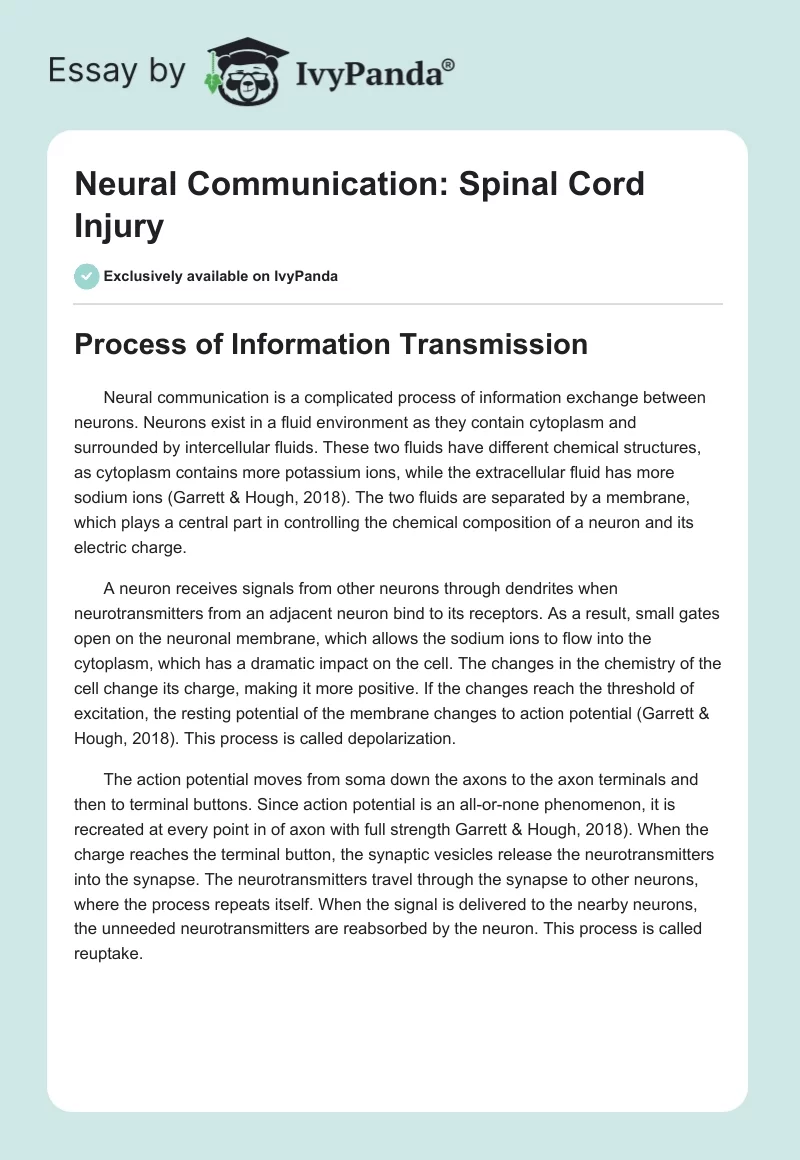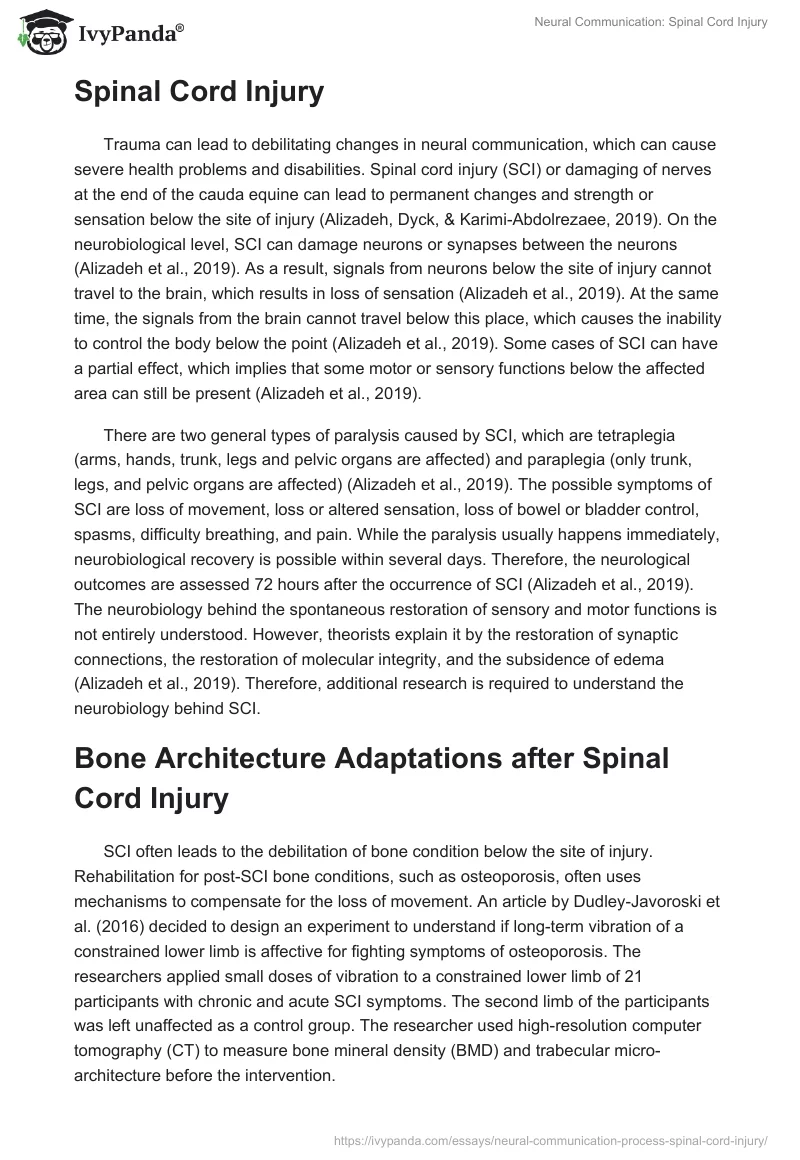Process of Information Transmission
Neural communication is a complicated process of information exchange between neurons. Neurons exist in a fluid environment as they contain cytoplasm and surrounded by intercellular fluids. These two fluids have different chemical structures, as cytoplasm contains more potassium ions, while the extracellular fluid has more sodium ions (Garrett & Hough, 2018). The two fluids are separated by a membrane, which plays a central part in controlling the chemical composition of a neuron and its electric charge.
A neuron receives signals from other neurons through dendrites when neurotransmitters from an adjacent neuron bind to its receptors. As a result, small gates open on the neuronal membrane, which allows the sodium ions to flow into the cytoplasm, which has a dramatic impact on the cell. The changes in the chemistry of the cell change its charge, making it more positive. If the changes reach the threshold of excitation, the resting potential of the membrane changes to action potential (Garrett & Hough, 2018). This process is called depolarization.
The action potential moves from soma down the axons to the axon terminals and then to terminal buttons. Since action potential is an all-or-none phenomenon, it is recreated at every point in of axon with full strength Garrett & Hough, 2018). When the charge reaches the terminal button, the synaptic vesicles release the neurotransmitters into the synapse. The neurotransmitters travel through the synapse to other neurons, where the process repeats itself. When the signal is delivered to the nearby neurons, the unneeded neurotransmitters are reabsorbed by the neuron. This process is called reuptake.
Spinal Cord Injury
Trauma can lead to debilitating changes in neural communication, which can cause severe health problems and disabilities. Spinal cord injury (SCI) or damaging of nerves at the end of the cauda equine can lead to permanent changes and strength or sensation below the site of injury (Alizadeh, Dyck, & Karimi-Abdolrezaee, 2019). On the neurobiological level, SCI can damage neurons or synapses between the neurons (Alizadeh et al., 2019). As a result, signals from neurons below the site of injury cannot travel to the brain, which results in loss of sensation (Alizadeh et al., 2019). At the same time, the signals from the brain cannot travel below this place, which causes the inability to control the body below the point (Alizadeh et al., 2019). Some cases of SCI can have a partial effect, which implies that some motor or sensory functions below the affected area can still be present (Alizadeh et al., 2019).
There are two general types of paralysis caused by SCI, which are tetraplegia (arms, hands, trunk, legs and pelvic organs are affected) and paraplegia (only trunk, legs, and pelvic organs are affected) (Alizadeh et al., 2019). The possible symptoms of SCI are loss of movement, loss or altered sensation, loss of bowel or bladder control, spasms, difficulty breathing, and pain. While the paralysis usually happens immediately, neurobiological recovery is possible within several days. Therefore, the neurological outcomes are assessed 72 hours after the occurrence of SCI (Alizadeh et al., 2019). The neurobiology behind the spontaneous restoration of sensory and motor functions is not entirely understood. However, theorists explain it by the restoration of synaptic connections, the restoration of molecular integrity, and the subsidence of edema (Alizadeh et al., 2019). Therefore, additional research is required to understand the neurobiology behind SCI.
Bone Architecture Adaptations after Spinal Cord Injury
SCI often leads to the debilitation of bone condition below the site of injury. Rehabilitation for post-SCI bone conditions, such as osteoporosis, often uses mechanisms to compensate for the loss of movement. An article by Dudley-Javoroski et al. (2016) decided to design an experiment to understand if long-term vibration of a constrained lower limb is affective for fighting symptoms of osteoporosis. The researchers applied small doses of vibration to a constrained lower limb of 21 participants with chronic and acute SCI symptoms. The second limb of the participants was left unaffected as a control group. The researcher used high-resolution computer tomography (CT) to measure bone mineral density (BMD) and trabecular micro-architecture before the intervention.
The treatment was applied to the patients for a 12-month period, after which the BMD and trabecular micro-architecture were measured once again. The results demonstrated that the proposed preventative treatment for osteoporosis had no effect on patients. Therefore, vibration training of 0.6g, with 30 Hz for 20 minutes three times a week, should not be used to prevent osteoporosis. Future research may focus on vibration training of different intensity to improve the generalizability of findings.
The reasoning behind the study was that currently, osteoporosis in SCI patients is addressed using “exogenous mechanical loading to subsidize the mechanical loads lost from muscle contraction and weight bearing” (Dudley-Javoroski et al., 2016, p. 1150). Mechanical loads are considered dangerous for human health; therefore, less risky interventions were needed to be designed. The hypothesis of Dudley-Javoroski et al. (2016) was no confirmed; therefore, additional research is required to understand how the problem of osteoporosis can be addressed in SCI patients.
References
Alizadeh, A., Dyck, S., & Karimi-Abdolrezaee, S. (2019). Traumatic spinal cord injury: An overview of pathophysiology, models and acute injury mechanisms. Frontiers in Neurology, 10. Web.
Dudley-Javoroski, S., Petrie, M. A., McHenry, C. L., Amelon, R. E., Saha, P. K., & Shields, R. K. (2016). Bone architecture adaptations after spinal cord injury: Impact of long-term vibration of a constrained lower limb. Osteoporosis International, 27(3), 1149-1160.
Garrett, B., & Hough, G. (2018). Brain and behavior: An introduction to behavioral neuroscience (5th ed.). Los Angeles, CA: SAGE Publications, Inc.


